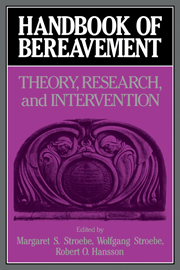Book contents
- Frontmatter
- Contents
- Contributors
- Preface
- Part I Introduction
- Part II The phenomenology and measurement of grief
- Part III Current theories of grief, mourning, and bereavement
- Part IV Physiological changes following bereavement
- Part V The psychological, social, and health impacts of conjugal bereavement
- 12 The mortality of bereavement: A review
- 13 Psychological resilience among widowed men and women: A 10-year follow-up of a national sample
- 14 Determinants of adjustment to bereavement in younger widows and widowers
- 15 The impact of spousal bereavement on older widows and widowers
- 16 The course of spousal bereavement in later life
- 17 Risk factors in bereavement outcome
- Part VI Grief reactions to different types of loss
- Part VII Coping, counseling, and therapy
- Part VIII Conclusions
- References
- Author index
- Subject Index
16 - The course of spousal bereavement in later life
Published online by Cambridge University Press: 04 May 2010
- Frontmatter
- Contents
- Contributors
- Preface
- Part I Introduction
- Part II The phenomenology and measurement of grief
- Part III Current theories of grief, mourning, and bereavement
- Part IV Physiological changes following bereavement
- Part V The psychological, social, and health impacts of conjugal bereavement
- 12 The mortality of bereavement: A review
- 13 Psychological resilience among widowed men and women: A 10-year follow-up of a national sample
- 14 Determinants of adjustment to bereavement in younger widows and widowers
- 15 The impact of spousal bereavement on older widows and widowers
- 16 The course of spousal bereavement in later life
- 17 Risk factors in bereavement outcome
- Part VI Grief reactions to different types of loss
- Part VII Coping, counseling, and therapy
- Part VIII Conclusions
- References
- Author index
- Subject Index
Summary
The overall purpose of this chapter is to provide an overview of the major findings from our research over the past 11 years on spousal bereavement among older adults in the United States. We began in 1980 with a longitudinal study funded by the National Institute on Aging (NIA) designed to describe, from a multidisciplinary perspective, the process of adjustment that follows the death of a spouse, examine factors that influence the observed outcomes, and identify potential focuses and strategies for intervention. A sample of 192 recently bereaved spouses and a control group of 104 currently married adults over the age of 50 participated in the study. Findings from this project were used to develop a second study, also funded by NIA, to examine the effectiveness of selfhelp groups in facilitating the bereavement adjustment process. Another sample of 339 recently bereaved spouses participated in this intervention study, with 241 assigned to self-help groups and 98 assigned to a control condition.
In the late 1970s, the National Institute on Aging recognized that little or no empirical research on bereavement had been completed that specifically focused on older adults. Although some studies had included older adults in their samples, there was no systematic attempt to learn more about their bereavement experiences until NIA established bereavement and aging as a priority for research funding. Our first study was one of three that the institute initially supported.
- Type
- Chapter
- Information
- Handbook of BereavementTheory, Research, and Intervention, pp. 240 - 254Publisher: Cambridge University PressPrint publication year: 1993
- 62
- Cited by



